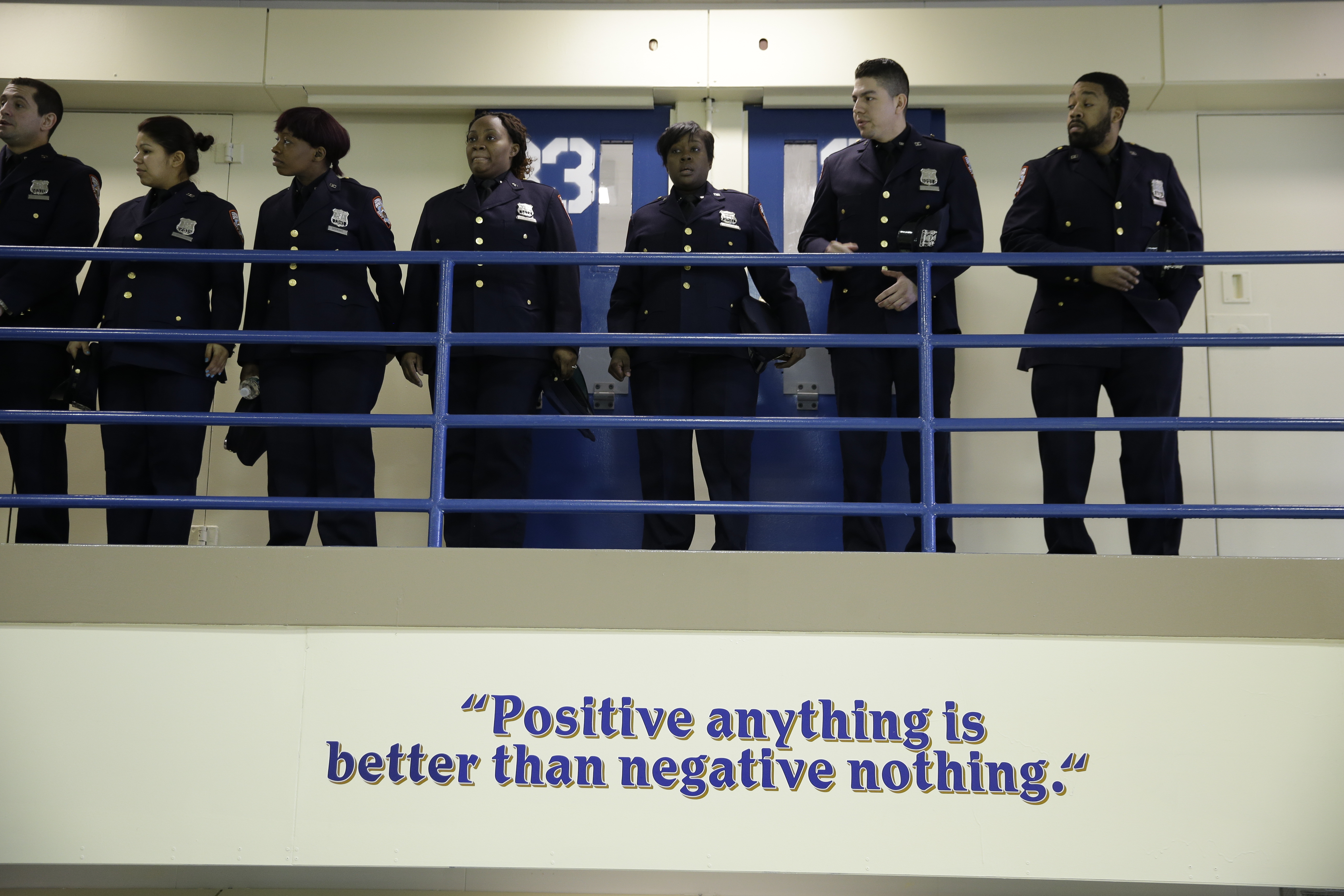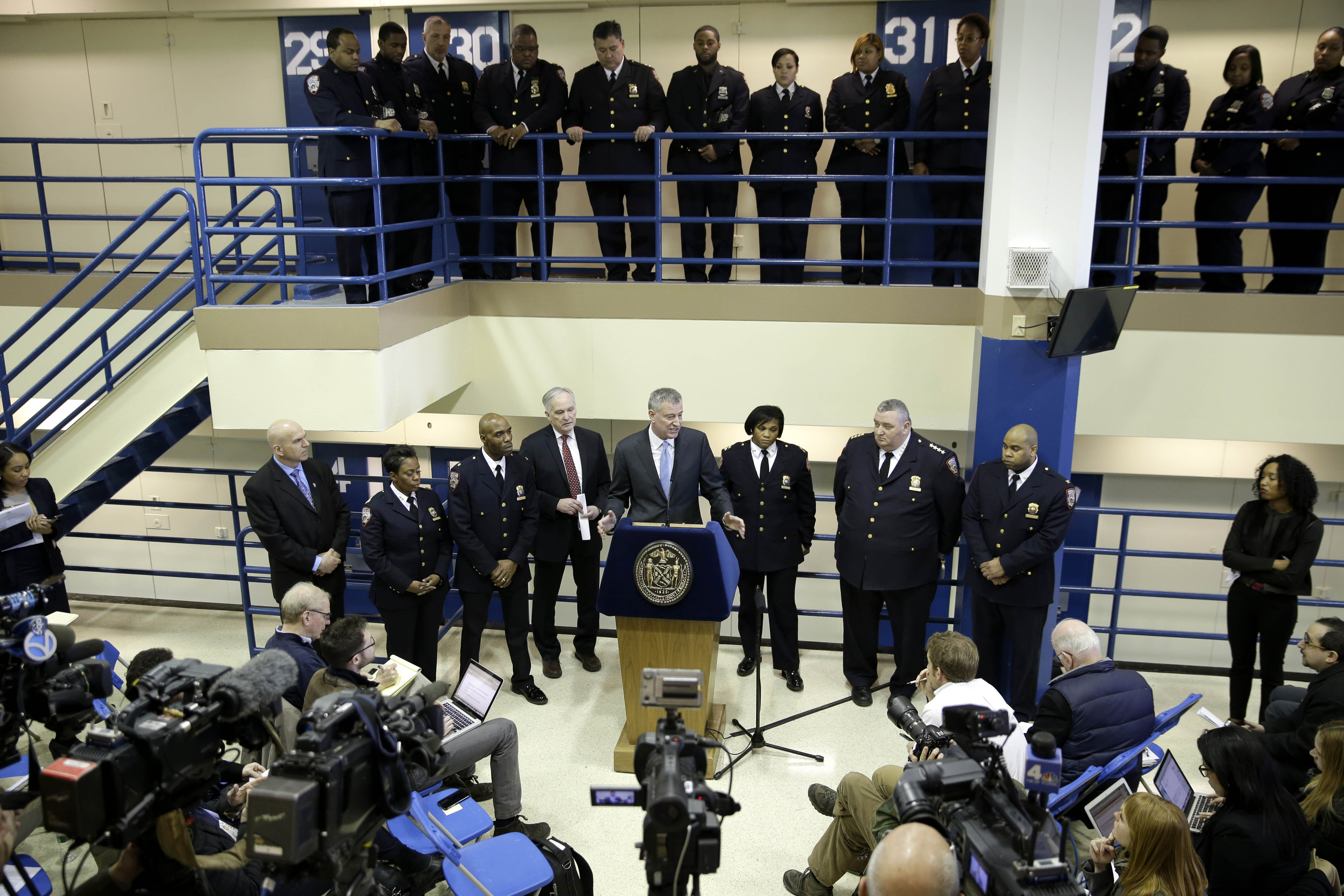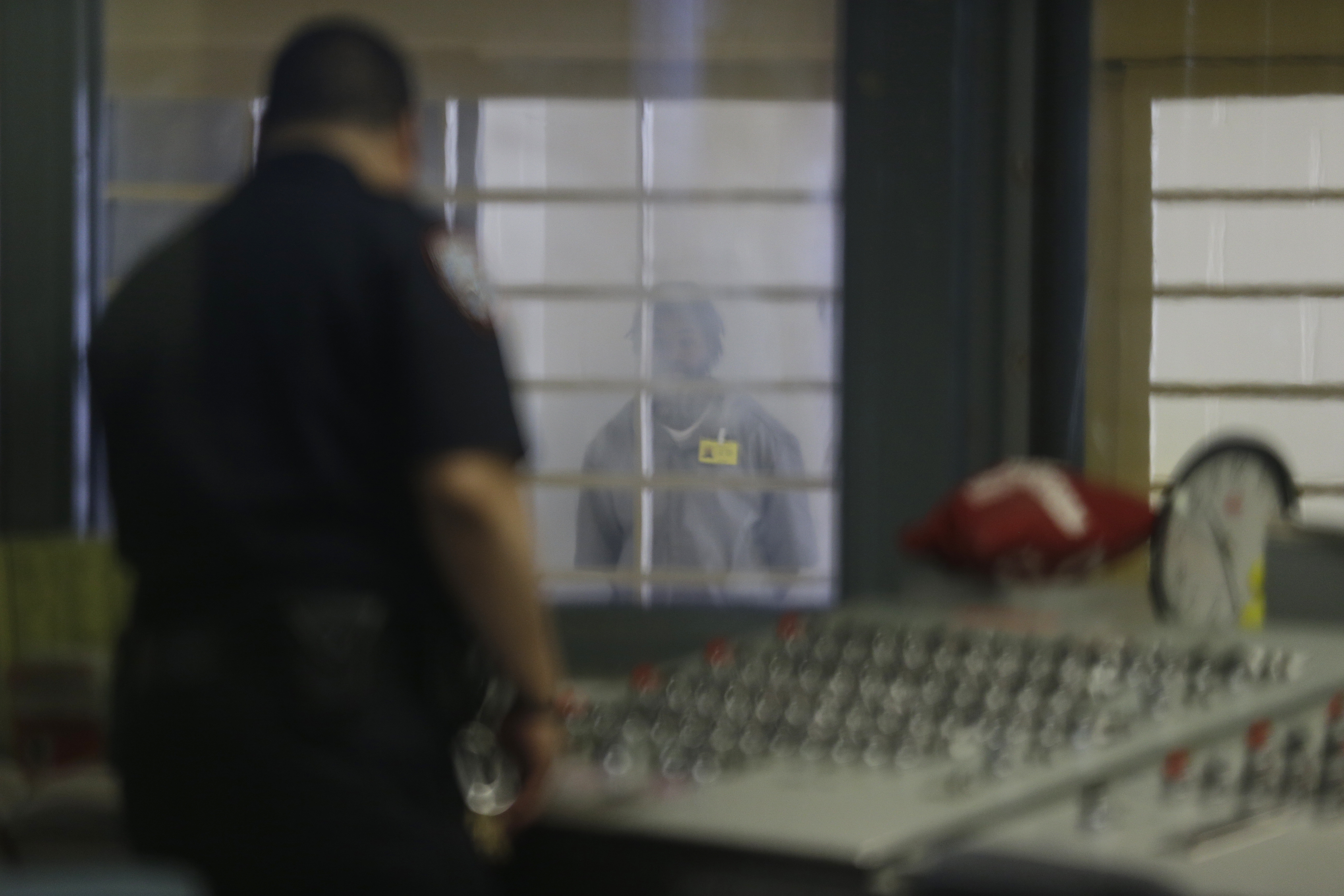In July, David* was told he was being moved to a new unit. He was taken from a general-population unit on Rikers to one of the recently opened Enhanced Supervision Housing units (ESHU) at the Otis Bantum Correctional Center. The unit was a stark difference from general population: In ESHU you get seven hours out-of-cell time a day; in general population, you’re entitled to 14 hours minimum out-of-cell time, as mandated by the Board of Correction’s standards.
David has been in various different housing units on Rikers, including the unit that’s often referred to as solitary confinement: punitive segregation. Yet he considers the Enhanced Supervision Housing unit the worst of them all. “Right now, we’re locked down because one or two guys were wearing tank tops,” David told me. “For nothing verbal, no fights, but because we’re wearing tank tops…. We’re barely ever [given out-of-cell time]. They’ll lock us in [isolation] for something like wearing tank tops [or] for speaking up for yourself.” David says that between October 7 and October 28 (22 days), he’s only been given out-of-cell time 11 times. “It’s like I never got out of the Box.”
Michael*, who was held in ESH for four months, said the unit was often locked down “for any little reason. [If] an inmate won’t lock in on the bottom floor, the top floor remains locked in for longer than they’re supposed to.” He told The Nation he was often locked in all day. Regardless of rule breaking, because the department alternates the time slot that each tier comes out each day, every other day inmates housed in an ESH unit are held in solitary confinement, isolated in their cells for 22–24 hours.
David says guards attack them with MK-9, similar to the spray that the NYPD often uses on protesters, for minor transgressions. According to the BOC report that looked at ESH during its first two months, guards used “Use-of-Force-C” tactics (which include pepper spray) more often in ESH units than in Bing Lite, a punitive segregation unit, or in maximum-security general-population units. David told The Nation the spray had been used in his unit about 12 times so far in the past month and is often sprayed when a detainee does “anything [the guards] don’t want him to do.”
“They’ll spray you for refusing to go to court, for not locking in. I got sprayed once for walking to the pantry to get food,” David told The Nation.
“Commissioner Ponte is aggressively combating violence in our jails, as demonstrated by clear reductions in violence in the areas where his targeted reforms have taken hold and a decline in the most severe uses of force,” a spokesperson for the DOC told The Nation.
* * *
Through a strange twist of New York City politics, Enhanced Supervised Housing has been promoted as part of the reform package designed to counter the use of solitary confinement at Rikers. According to Department of Correction Commissioner Joseph Ponte, ESH is different from punitive segregation because it’s rehabilitative and not punitive. He has promoted the units, which have a total capacity of 250, as a positive prison reform, as has Mayor Bill de Blasio. In January, the eight-person Board of Correction approved the unit within a package of solitary reforms that the board had been working on since at least October 2013. The sweeping solitary reforms restricted the use of punitive segregation to 30 days with a mandatory seven-day break outside of segregation. The solitary reforms also included banning 16- and 17-year-olds from punitive segregation, as well as people deemed mentally ill by the Department of Health. The solitary reforms were the result of a year-long process where the board met with stakeholders like the Department of Health, the Department of Correction, the union, and advocates such as the Legal Aid Society, the Vera institute, and the Jails Action Coalition.
Popular
"swipe left below to view more authors"Swipe →
In June 2014, while the board was considering reforms to solitary confinement, Bill de Blasio allocated $27.3 million dollars for the Department of Correction to create the new ESHU, prior to its approval by the board. Between July and November, the public scrutiny on what was occurring on Rikers Island increased tenfold because of a New York Times investigation and a federal government inquiry by US Attorney Preet Bharara that found Rikers to have a “deep-seated culture of violence.” The US inquiry specifically looked at the treatment of adolescents by guards at Rikers and led to a lawsuit. In October, Mayor de Blasio appointed three new members to the board in order to fill vacancies: Jennifer Jones Austin, Derrick Cephas, and Steven Safyer. Three weeks later, Commissioner Ponte submitted the Enhanced Supervision Housing Unit as a proposal to the Board of Correction.
When Commissioner Ponte presented the ESHU to the board at this November public meeting, he referenced an increase in the level of violence on Rikers. Slashings have increased from 35 in 2011 to 90 in 2014. (While slashings have increased slightly each year since 2011, they are still at a historical low compared to the 1,552 slashings that occurred in 1990.) Assaults on guards have increased by 50 percent. Guard-on-inmate use-of-force incidents have increased from 1,299 in 2006 to 4,074 in 2014. The ESHU was necessary, he argued, to control the most dangerous and violent inmates. The department’s objective was to classify people most likely to commit violence, and prevent violent acts from occurring by putting them in the ESHU. Crucially, for the proceedings at hand, he argued that, before the Department of Corrections could move forward with reforms to solitary confinement, they needed this new unit.
After Ponte’s presentation, Jennifer Jones Austin, the CEO of Federation of Protestant Welfare Agencies and the co-chair of Mayor de Blasio’s transition committee in 2013, motioned to put the ESHU proposal into the solitary-reform package. Citing the current state of Rikers Island, Jones Austin said the crisis required unusual expedient action. (Jones Austin declined to comment for this article.) Michael Regan seconded her motion. Describing Commissioner Ponte as a reformer, Regan said, “The statistics [detailing violence on Rikers] are unbelievable. The statistics are sobering and horrendous.” Other board members—Bryanne Hamill and Bobby Cohen—objected. Both noted the rushed proceedings to put ESHU into the solitary reform package. The rulemaking process is often long and deliberate. But in this case, the board had just received the proposed rule the night before.
“This process [today] is flawed,” Bryanne Hamill said to her fellow board members. “It is nothing short of sandbagging the Board of Correction which is meant to be an independent oversight and regulatory authority…. [It is] potentially a breach [of] our responsibilities to the City of New York.”
Bobby Cohen addressed the board, as well: “The process of rulemaking on solitary confinement began over a year ago,” Cohen said. “This [Enhanced Supervised Housing] proposal discards a years worth of conversations, hearings, research…[and what the department is saying is] if you allow us ESH then we will let you make a rule that says people who did something ten years ago and have days in owed time, we will no longer put them in solitary confinement.”
But the voting moved forward, regardless: Six board members voted in favor and two voted against it. The ESHU was to be included in the solitary reform package.
At a hearing on December 19, 2014, more than 100 people, including formerly incarcerated individuals, lawyers, City Council members, family members of the incarcerated, and advocates from the Brooklyn Defenders, Legal Aid Society, the Osborne Association, Jails Action Coalition, and the Bronx Defenders came out against the ESH unit. The public that day accused the department of trying to roll back the solitary confinement reforms that the board had been focusing on for so long.
The following month, the vote was passed unanimously, under tremendous pressure to fix the jail. “I voted in favor of ESH at the meeting in January, but only because my vote was necessary in order to get solitary confinement elimination for 21-year-olds and under into the rules. I never thought that ESH was a good idea,” Bobby Cohen, who has been on the Board of Correction for six years, told The Nation.
“Violence increases with the use of isolation,” Bryanne Hamill said during the January vote. “My preference to start the meaningful solitary confinement [reforms] that we commenced a year ago, feels to me that it’s held hostage to the enhanced supervision unit.”
When the unit opened on February 23, 2015, Commissioner Ponte said the unit was “a cornerstone of our agenda of meaningful reform at Rikers.” He also noted that the ESHU would “allow” the department to make certain solitary confinement reforms.
* * *
Each of the freshly opened ESH units has 21 cameras, 50 beds, and a higher staff-to-inmate ratio. But despite being in a newly built prison, David, a 26-year-old who stands at 6′ 2″, says he often sleeps on the floor because he can’t fit on the bed (which goes from wall to wall in the cell). The situation sometimes deprives him of sleep. “Honestly, if I didn’t have children, I would harm myself,” he told The Nation.
The unit uses a predictive analysis to decide which inmates “have a propensity of violence” and are therefore eligible for the unit. While little is known about the specific predictive analysis they use, detainees who have been accused of certain activity within the past five years—including a Security Risk Group (SRG) classification, perpetrating or organizing a gang-related assault, fighting, committing a stabbing or slashing, possessing a scalpel, or participating in riots, protests, or disturbances—are eligible for ESH. Critics also note that the main difference between ESH and traditional solitary confinement is that solitary is more clearly regulated. Inmates can be held in solitary only for specific infractions and for a specific period of time (a maximum of 30 days), whereas inmates sent to an ESHU could be held there indefinitely, based on the idea that they have the propensity to commit violence in the future.
Eight months after the ESHU opened its doors, people detained inside the unit recount arbitrary reasons for being placed there, often for infractions that occurred years ago. When David was put into the unit, he was told it was for two reasons: an allegation that he was in possession of a scalpel, and an assault on staff that occurred in 2011. Between 2011 and now, David left Rikers and completed his sentence at a state prison and was paroled (he’s back in Rikers on a parole violation). Although David mentioned that he beat the scalpel allegation during his solitary hearing and it was dismissed, he was put in ESH for the accusation, regardless.
“Why am I being punished for the same thing twice?” David exclaimed to The Nation in a phone interview. “I did the box already…. I don’t owe any days [in punitive segregation]. Did I not pay already?” He went on to describe a fellow detainee housed in ESH: “they told one guy he’s in here because he’s influential [but] they never showed any proof or evidence…. he just got to Rikers a couple days ago.”
As of April 30 (the last publicly available ESH report), 59 percent of the people housed in an ESH unit had a mental-illness diagnosis and 63 percent were in a Security Risk Group. They had spent an average of 543 days on Rikers Island.
The department classifies people into a Security Risk Group (DOC’s term for “gang”) if they wear scarves or jewelry that are yellow and black, white and black, or white, red and black. Wearing these color groupings is also a Grade 2 infraction that can result in punitive segregation. DOC can also classify someone into an SRG based on the word of a jailhouse informant or intelligence from the DOC, the NYPD, or the FBI.
“The standards used to classify people as gang members [are] extremely broad and over-inclusive,” Riley Doyle Evans, the jails services coordinator for the Brooklyn Defenders, told The Nation. “For example, one thing used to label people SRG members is their ‘association’ with other known Security Risk Group members. If you are housed in the jail with people identified as such, it is extremely hard to avoid associating with them—it’s a self-fulfilling prophecy.”
Even the Department of Health Commissioner Mary Bassett was wary of the accuracy of predicting violent events. “Speaking as a public-health physician, the occurrence of violence events is actually, although horrible…relatively rare,” Bassett said at the ESHU presentation. “For example, I think I saw on one of the slides, 88 slashings [in a year] out of 11,000 inmates that’s a relatively rare event. It is very, very difficult to predict rare events.”
Now the people housed in ESH units are different from what Commissioner Ponte had originally described—perhaps in part because of the broad criteria of who could be placed there.
“If we’re talking about the people who are persistently aggressive, we’re talking about the override patients” being held in solitary confinement, Homer Venters, who oversees health services on Rikers Island as the assistant commissioner of the Bureau of Correctional Health Services, said last month at a BOC meeting. “My sense is those aren’t really the patients that are in ESH. When I’m in ESH, the patients there are not acting out on a daily basis. The unit is relatively calm…. Some are interested in just getting back to GP. Others are interested in some of the programming.”
If ESH was a covert way to rollback on solitary-confinement reforms, then the department has since decided to no longer be obscure. In their upcoming proposal, the DOC asked for the right to waive three times over a period of four months the mandatory seven-day break between 30-day sentences in punitive segregation, if an inmate commits a certain infraction. The board was expected to vote on this proposal today, November 10, 2015, but has postponed the vote. The waiver would mean that the department, with the 60-day override, could hold someone indefinitely in solitary confinement with no mandatory break. (Without exercising the 60-day override, the department would be allowed to keep inmates in solitary for 67 days.) Requesting this waiver on July 8, 2015, Commissioner Ponte stated once again that this proposal would be used for the most dangerous people on the island. When reminded that that was what ESH units are for, Ponte said ESH was not an appropriate alternative to punitive segregation for the most violent inmates—which was inconsistent with what he had said a year earlier.
“The department [now] states that people in ESH are not particularly violent—that they can’t use it for people who have been discharged from solitary confinement because it’s not a secure enough unit,” board member Bobby Cohen told The Nation. “I think [ESH] was misrepresented to the board. It’s a punitive, administrative segregation unit that is not being used for what it was supposed to be used.”
Riley Doyle Evans told The Nation that “during the hearings last year, the department explained that this unit was designed for the most difficult-to-manage people in the system, in order to reduce reliance on long-term solitary.” Now, he explains, it appears “that the people who are in ESH units may not in fact be those folks, and unfortunately, many people, including many people with mental illness made worse by isolation, remain in long-term solitary confinement on overrides. About $20 million of the mayor’s mental-health budget on this unit and it’s not clear at this point how the unit fits this mission.”
A couple months ago, on September 8, 2015, some inmates in 1 West (one of two open ESH units) had had enough. David admitted the conditions in his ESH unit led him to start a riot. “People were fed up,” he said. “I lost my cool, but there’s only so much you can take. It was 95 degrees and there’s no central air here [on Rikers Island]. We call it the oven.” Guards used MK-9 and David was sentenced to 30 days in punitive segregation for rioting. When he got out, he was placed back in ESH. But for people incarcerated in ESH, the frustration has not subsided: “I’m at the point now where I hope it burns down and never comes back up,” one inmate told me. (The DOC declined to comment on the disturbance.)
Both David and Michael described ESHU as being similar to punitive segregation. “It is the Box [solitary confinement]. It’s just a slick way around it,” David told The Nation. “I’ve done four years in the Box and honestly, there’s really no difference.”
[* Names of inmates incarcerated in ESHU have been changed.]





